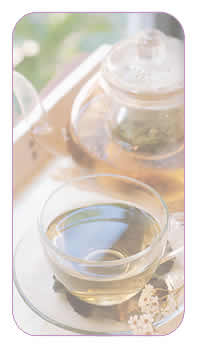| |


White teas are produced in the Fujian province of China’s
east coast; the productions are limited and rare. White
teas are picked before the tea buds open up. They’re
put through a quick-drying process with steam and fire
to prevent oxidation. Their leaves tend to be more pale
and less fragrant than other teas. One becomes aware of
subtle changes in breath (and mouth) while drinking these
teas. Pai Mu Tan (white hairy monkey tea), Pai Loong Chu
(white dragon ball tea) and Pai Hai Yin Chin (silver needle
tea) are the most popular and well-known kinds of white
teas.

Green teas are greenish in color often with a yellowish
tone. The leaves are freshly picked, then heat-treated
to stop any oxidation; they’re also called non-fermented
teas. The leaves are then traditionally left to dry on
bamboo racks exposed to the open air and sun. This differs
from other teas which are put through an oxidation process
which darkens the leaves. The unique process is responsible
for the leaves distinct green color and other properties.
Lo Chu Ch’a (gunpowder tea), Polee tea, Ho Chin
(pine needle tea), Jasmine, Lung Ching tea and Matcha
Uji (Japanese powdered green tea) are some of the well-known
kinds of green teas.

Most of the sellers list Oolong teas as a Green tea. However,
the drying process is slightly different--Oolong teas
are semi-fermented (Green teas are non-fermented). They’re
produced along the western border of the Fujian province
in China and Taiwan. The leaves must not be picked too
soon and have to be processed immediately after plucking.
During the period of oxidation, the leaves turn slightly
yellow with reddish color on the edges. Oolongs are always
formed as whole leaf teas and often used as a base for
Jasmine and other scented teas. Different regions have
produced their own famous Oolong teas. WuYi Rock Tea is
considered to be the most famous in Northern province
while Tee GuanYin is the most well-known in the South.
Phoenix ShuiXian tends to be the best example in Canton,
and Dong-Ding in Taiwan.

The process of producing black teas is unlike the ways
that green teas and Oolong teas are made. Black teas are
fully fermented while Oolong teas are semi-fermented and
green teas are non-fermented. These teas go through four
basic steps in their production: withering, rolling, fermenting
and drying. Leaves have to be exposed to the air after
being rolled and crushed, then oxidized, causing a major
chemical change. This is evident as the leaves changing
from green to a coppery red color. The taste of black
teas are generally bittersweet, slightly varying with
additional sips. Black teas are the most common tea in
contrast to the other varieties. Keemun, Lapsang Souchong,
Assam, Darjeeling, Earl Grey and English Breakfast are
some of the best known black teas.

As society becomes more environmentally and health conscience,
organic teas gain popularity . They’re developed
absolutely free of chemicals avoiding commercial fertilizers,
herbicides and pesticides. Today, some of the finest quality
organic teas are produced in India, Africa and Sri Lanka.

Herbal teas are also considered caffeine-free teas, and
are not made from the same plants as green, oolong and
black teas. Instead, they’re made from flowers,
seeds and barks and possess refreshing, calming, and exotic
features.
|
 |